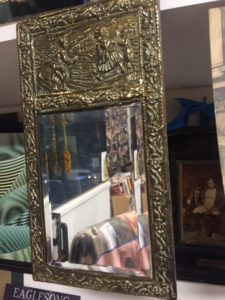 EP owns a little pressed brass beveled glass mirror, inherited from her grandmother. The repoussé design of the courting couple depicted gives away its date. She’s in a hoop skirt, and he’s in knickers and Dutch clogs. Think of all those Hollywood costume drama of the 1930’s and you’ll know the style. These little decorative wall mirrors were part of a dressing set which included a marching repoussé comb and hand held mirror. Repoussé is a technique of pounding the back of a pliable metal so that a relief tableau is raised, and became a popular art form in from Germany and Holland. Beveled mirrors were not common. Large beveled glass surfaces had to be hand ground and were pricey.
EP owns a little pressed brass beveled glass mirror, inherited from her grandmother. The repoussé design of the courting couple depicted gives away its date. She’s in a hoop skirt, and he’s in knickers and Dutch clogs. Think of all those Hollywood costume drama of the 1930’s and you’ll know the style. These little decorative wall mirrors were part of a dressing set which included a marching repoussé comb and hand held mirror. Repoussé is a technique of pounding the back of a pliable metal so that a relief tableau is raised, and became a popular art form in from Germany and Holland. Beveled mirrors were not common. Large beveled glass surfaces had to be hand ground and were pricey.
The “looking glass” is an amazing invention. It reflects light, which, by the wavelength recreated, is reflected back. The mirror preserves the detailed look of the original light’s reflection. Other surfaces also reflect, but not as perfectly as a modern day mirror. EP’s is a silvered glass mirror, typical of its age. The most common form of mirror manufactured, it’s coated on the back of the glass with a silver on copper film encased in the necessary waterproof coating to keep away tarnish, acid, and moisture.
Mirrors create what is amazingly called “a mirror image”
I cannot describe or explain this. Even though our modern mirrors are accurate, we don’t see ourselves. The long history of mirrors is an attempt to see ourselves as we are seen.
Earliest mirrors consisted of polished stone. Cultures used polished copper, dating back 8,000 years. In my opinion, the early Chinese made the most gorgeous antique mirrors. Some date to 2000 BC, yet produced until the 18th century as hand mirrors for the wealthy. These quite tiny mirrors reflect only a part of the face at a glance, because to get a large polished flat bronze surface is almost impossible. When I look at myself in that mirror I don’t see colors well, I see myself as a cloudy shadow, which isn’t a bad thing these days.
The earliest mirrors were made of a blown bubble of glass
Then a small circle was cut out of one side of the big bubble. Yes, the sides will have some curve and some distortion, but the larger the bubble, the more clear the little “cut” might be. Image how hard glassblowers worked to achieve this. Therefore these little mirrors, dating before the 16th century, were no bigger than seven inches in diameter. These glass circlets were coated, in Roman times, with pounded gold leaf for only the wealthy.
The mid 19th century marks a development in the technique used to coat the back of the glass called electroplating. A pre 19th century mirror will be very small, with wavy glass, and through the glass, you’ll see streaks of silver that show tarnish and flaking. I own a 18th century French mirror that must have cost a nobleman a fortune, because it’s comprised of two six-inch long panels of silvered glass joined together in one frame.
These old mirrors required bright light in which to see your reflection and in candlelit rooms, only the candle flame would truly be reflected. This fact enabled the great palace Halls of Mirrors of the 17th century to flourish in Europe. They discovered a candlelit sconce when backed by a mirror created MORE light. If you’ve seen the Hall of Mirrors in Versailles, remember such a Hall was worth a King’s ransom, literally. We take that for granted when we see a whole skyscraper covered in a mirrored surface today.
EP, the history of your grandmother’s mirror includes the complex history of optics. We’re inheritors of mirrors through time, as modern TV’s, telescopes, surgical and scientific instruments, digital cameras all use tiny multiple mirrors. Another term for the multicity of mirrored surfaces is “a pixel.” Your mirror reflected your grandmother, and now it reflects you. This has a history throughout the history of art. Mirror gazing, look long enough to “see” yourself, the dictum from the Greek era.
Yet the mirror itself is essentially deceiving
Think of a Fun Hall of curved mirrors, or try to gaze into an antique mirror. We’re spoiled every morning when we look into our vast mirrors. Never before has a civilization been so aware (yet deceived by) our own face.
Very interesting as ALWAYs! You find such cool info on these treasures… btw you yourself are a treasure!